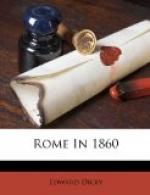Now the question as to the real aspect of the Papal pageantry, and the effects produced by it upon the minds, not of controversialists, but of ordinary spectators, is by no means an unimportant one with reference to the future prospects of Italy and the Papacy. Let me try then, not irreverently or depreciatingly, but as speaking of plain matters of fact, to tell you what you really do see and hear at the greatest and grandest of the Roman ceremonies. Of all the Holy Week services none have a more European fame, or have been more written or sung about, than the Misereres in the Sistine Chapel. Now to be present at these services you have to start at about one o’clock, or midday, in full evening costume, dress-coat and black trowsers. Any man who has ever had to walk out in evening attire in the broad daylight, will agree with me that the sensation of the general shabbiness and duskiness of your whole appearance is so strong as to overcome all other considerations, not to mention your devotional feelings. In this attire you have to stand for a couple of hours amongst a perspiring and ill-tempered crowd, composed of tourists and priests, for the Italians are too wise to trouble themselves for such an object. During these two mortal hours you are pushed forward constantly by energetic ladies bent on being placed, and pushed back by the Swedish guards, who defend the entrance. The conversation you hear around you, and perforce engage in, is equally unedifying, both religiously and intellectually, a




